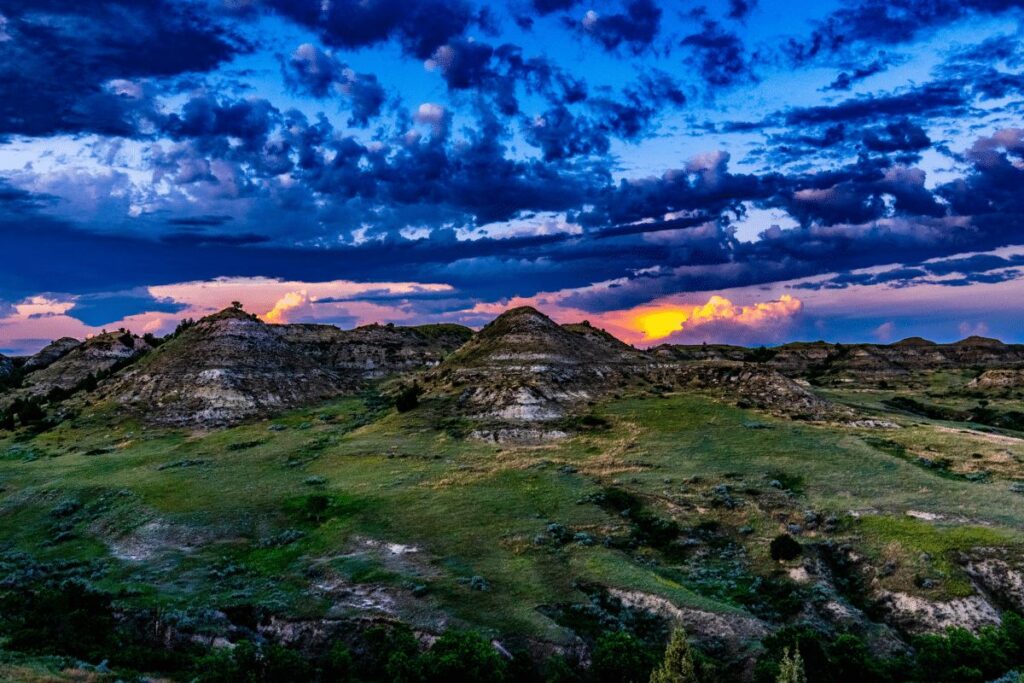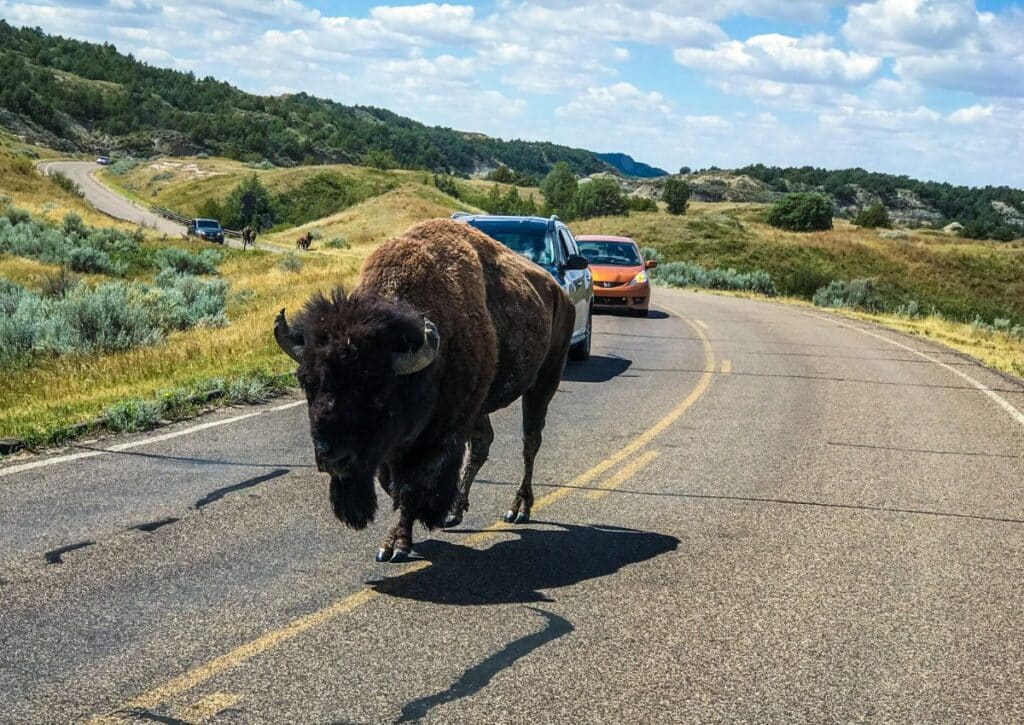Guide from Bismarck to Theodore Roosevelt National Park: scenic routes, wildlife encounters, and top stops. Plan your adventure and unveil park secrets!
Ready for a thrilling road trip from Bismarck to Theodore Roosevelt National Park? Buckle up! This guide will steer you through scenic routes, historic stops like Mandan, and the vibrant gateway of Medora.
But that’s just the beginning! Dive deeper and you’ll encounter majestic bison, playful prairie dogs, and echoes of the Wild West with wild horses.
Wondering where to cozy up for the night or if you can catch the northern lights in the park? We’ve got answers. From planning essentials to the park’s biodiverse sanctuary, we’ve mapped out everything for you.
So, rev up your engine, the adventure from Bismarck to Theodore Roosevelt awaits!
Route and Overview from Bismark to THeodore Roosevelt National Park
Bismarck is the state capital of North Dakota and is located in the south-central region of the state. The city has a population of 61,272 according to the 2010 census.
Bismarck was founded in 1872 and named after German chancellor Otto von Bismarck. The city is home to several historical landmarks such as the North Dakota State Capitol, the Dakota Zoo, and Fort Abraham Lincoln State Park.
Theodore Roosevelt National Park is located in western North Dakota and consists of three units: the North Unit, South Unit, and Elkhorn Ranch Unit.
The park covers 70,446 acres and was established as a national park in 1947. Theodore Roosevelt National Park was named after President Theodore Roosevelt who owned a ranch in the area now known as the Elkhorn Ranch Unit. The park is home to many species of animals such as bison, elk, deer, pronghorn, wild horses, coyotes, badgers, eagles, and hawks.
The distance between Bismarck and Theodore Roosevelt national park is 149 miles (240 kilometers). It takes around 2 hours and 32 minutes to drive from Bismarck to the park. The best route to take is Interstate 94 West/US-83 North.
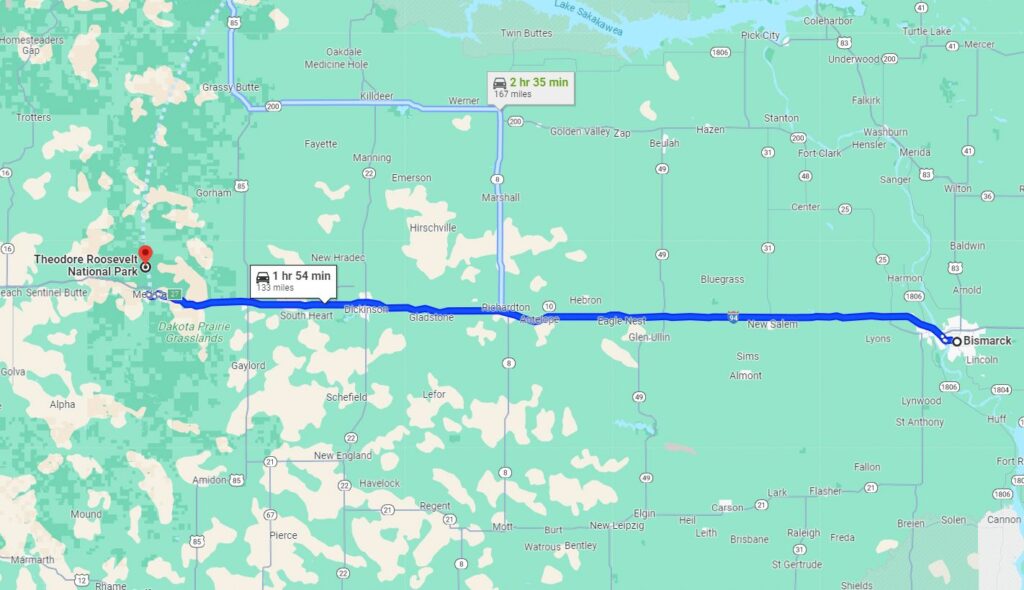
Visitors to Theodore Roosevelt National Park can explore various outdoor activities such as hiking, biking, fishing, horseback riding, rock climbing, bird watching, and photography. The park also offers scenic drives from both the north and south units. Visitors should remember to respect and adhere to the park regulations during their stay.
Bismarck to Theodore Roosevelt National Park: Stops Along the Way
The journey from Bismarck to Theodore Roosevelt National Park is not merely about reaching a destination. It’s a picturesque adventure that invites travelers to soak in the raw beauty of North Dakota.
Stretching over miles, this route offers numerous stops that present a blend of history, nature, and local culture. Here’s a more detailed look at the enchanting stops along the way:
1. Mandan: A Glimpse of the Past
As you drive out of Bismarck and approach Mandan, you’ll be greeted by a town that wears its history with pride. Nestled beside the Missouri River, the first major stop on your route offers an immersive journey into the past.
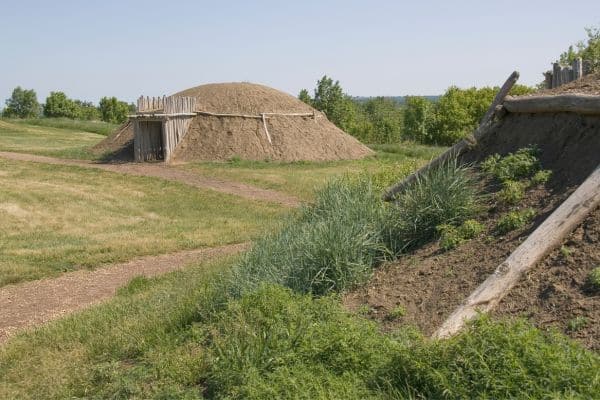
- Historic Downtown Mandan: Roam around the charming streets of Historic Downtown, where a blend of modern life meets vestiges from the past. From boutique shops to quaint cafes, there’s plenty to explore. Don’t forget to keep an eye out for murals and sculptures that tell tales of bygone eras.
- Knife River Indian Villages National Historic Site: A little further from the heart of Mandan lies this evocative site. Once a bustling hub for trade and agriculture, these preserved earthlodge villages allow you a peek into the life of the Northern Plains Indians. The on-site museum showcases artifacts and informative displays, ensuring both an educational and inspiring visit.
2. Medora: Gateway to Adventure
As you continue your drive, you’ll soon enter Medora, a town that feels straight out of a Western movie.
With its wooden sidewalks and rustic charm, Medora is not just a gateway to Theodore Roosevelt National Park but also a destination in its own right.
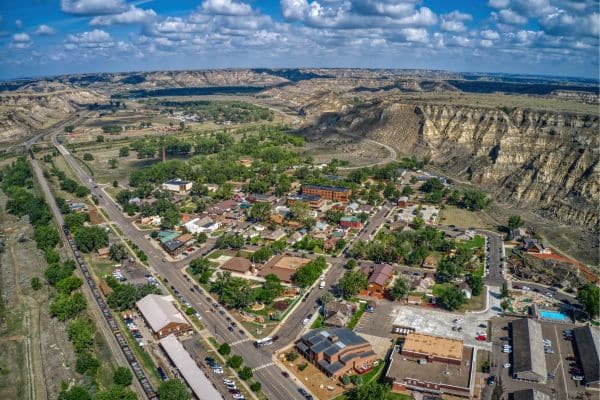
- Chateau de Mores State Historic Site: This 26-room chateau was once the summer home of the Marquis de Mores, who named the town after his wife, Medora. A tour of the chateau offers insights into the life of the 19th-century American frontier, from both the vantage of the Marquis and the town’s early inhabitants.
- Local Delights: Before heading to the park, treat yourself to some local cuisine in one of the town’s many eateries. Whether you’re in the mood for a hearty steak or a light salad, Medora has got you covered. And while you’re at it, perhaps pick up a souvenir or two from the local shops to remember your journey.
3. Cottonwood Campground: Nature’s Abode
Located just a stone’s throw from Medora, the Cottonwood Campground is a haven for those wanting to be close to nature.
With spacious campsites and basic amenities, it’s an ideal spot to relax under the starry skies before your exploration of Theodore Roosevelt National Park.
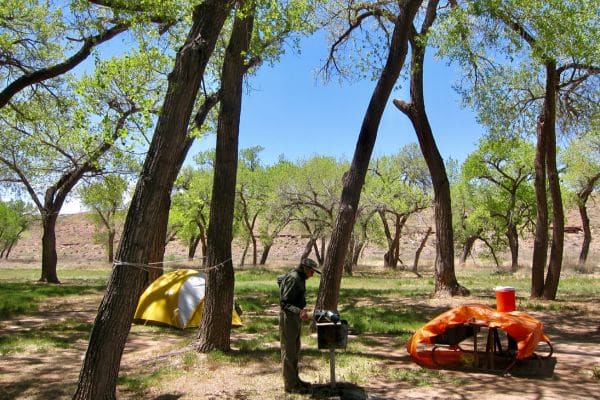
The gentle sounds of nature provide the perfect lullaby, ensuring you’re well-rested for the adventures ahead.
4. Theodore Roosevelt National Park: Natural Wonders Await
Having journeyed through towns steeped in history and culture, it’s now time to delve into the wild heart of North Dakota.
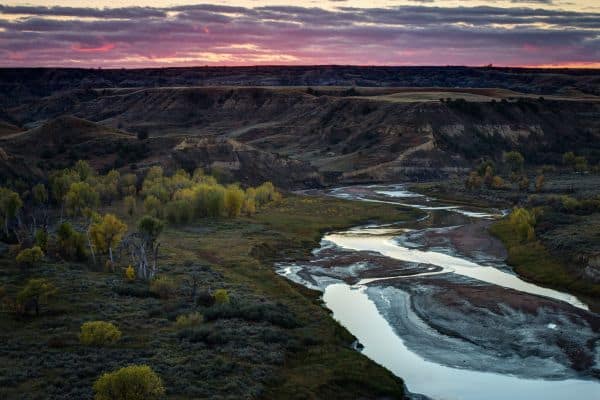
- Elk Point: One of the park’s most popular vantage points, Elk Point offers breathtaking views of the Badlands. On a lucky day, you might even spot a herd of elk grazing in the distance.
- Balanced Rock: A testament to nature’s artistic prowess, this geological formation looks like a giant stone teetering on a slender pedestal. It’s a sight that begs to be photographed!
- Hiking Trails: The park boasts a myriad of trails catering to both novice hikers and seasoned trekkers. Whether you’re looking to traverse dense forests, navigate rugged terrains, or simply enjoy a leisurely walk amidst nature, there’s a trail with your name on it.
The drive from Bismarck to Theodore Roosevelt National Park is not just a route but a journey dotted with memorable experiences.
Every stop along the way adds a unique flavor, ensuring that by the time you reach the park, you’re already brimming with stories and memories. Safe travels and happy exploring!
The Wildlife of Theodore Roosevelt National Park
Theodore Roosevelt National Park, sprawled across the rugged terrain of North Dakota’s Badlands, stands as a tribute not just to the 26th President of the United States, but also to the mesmerizing wealth of wildlife that calls it home.
The park’s sprawling landscapes, characterized by layered rock formations, dense forests, and vast grasslands, provide the perfect backdrop for a myriad of animals.
From the iconic bison that trudge through the grassy plains to the elusive bobcats lurking in the shadows, the park is a natural sanctuary where wildlife thrives in abundance.
1. Bison: The Majestic Grazers
Perhaps the most iconic animal associated with Theodore Roosevelt National Park is the American Bison. Once on the brink of extinction, these majestic beasts now roam the park’s expanses in healthy numbers, thanks to conservation efforts.
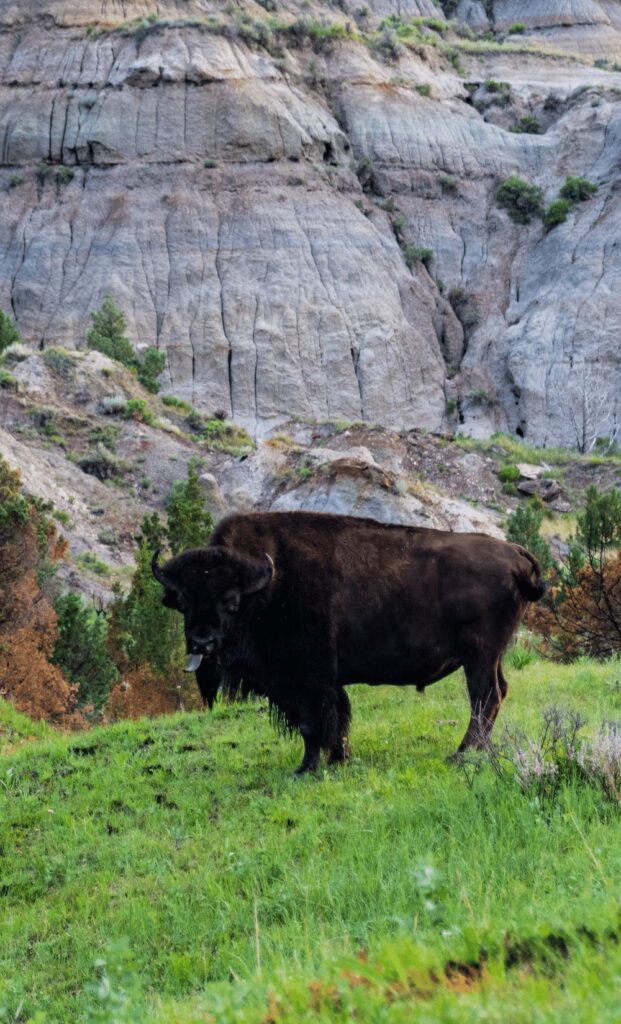
A sight of a bison herd grazing against the backdrop of the Badlands is nothing short of awe-inspiring. If you’re venturing out in the early morning or late afternoon, keep an eye out for these creatures, but always maintain a safe distance.
2. Prairie Dogs: The Playful Burrowers
At first glance, the vast grasslands might seem quiet. But if you look closely, you’ll notice the bustling towns of black-tailed prairie dogs. These small, social animals are known for their intricate burrow systems and amusing antics. Listening to their high-pitched calls and watching their interactions provides a delightful break during a hike.
3. Wild Horses: Echoes of the Wild West
The wild horses of Theodore Roosevelt National Park add a touch of magic to the landscape. These graceful animals, with their untamed spirits, evoke memories of the Old West. T
hough they roam freely, they are descendants of domesticated horses that were once released or escaped into the park. Their presence adds a dynamic energy to the park’s tranquil settings.
4. Elk and White-Tailed Deer: The Forest Dwellers
While bison and wild horses might dominate the open spaces, the park’s forests and wooded areas are the realms of elk and white-tailed deer. T
hese elegant herbivores are often spotted in the early mornings or evenings, foraging or gracefully navigating the terrains. If you’re a wildlife enthusiast, the sight of a majestic elk with its impressive antlers is not to be missed.
5. Predators: The Silent Stalkers
The park isn’t just home to grazers and burrowers. Top predators like coyotes, bobcats, and mountain lions also stake their claim here.
While these animals are elusive and sightings are rare, their presence is vital for maintaining the ecological balance.
The nocturnal bobcat, with its tufted ears and stealthy movements, is a special treat for those lucky enough to spot one.
Likewise, the coyote, often mistaken for a wolf, can sometimes be heard howling in the distant plains, especially during dawn or dusk.
6. Birds of the Sky: Feathered Beauties
For avian aficionados, Theodore Roosevelt National Park is a paradise. With over 186 species of birds recorded, the skies and trees are alive with a symphony of calls.
From the sharp-eyed golden eagles and red-tailed hawks soaring above to the melodic western meadowlarks and mountain bluebirds, the park offers a diverse array of bird-watching opportunities.
And let’s not forget the wild turkeys, often seen strutting about with their distinctive fan-shaped tails.
7. Reptiles and Amphibians: The Overlooked Inhabitants
Though they might not grab the headlines like their larger counterparts, the park’s reptiles and amphibians play a crucial role in its ecosystem.
From the ornate box turtles slowly trekking across the plains to the chorus frogs adding their songs to the park’s soundscape, these creatures offer a different dimension to the wildlife experience.
Among the rocks and shrubs, you might also find the swift Northern Prairie skink or the vivacious painted turtle basking in the sun.
8. Small Mammals: The Unseen Contributors
Beyond the larger, more visible animals, Theodore Roosevelt National Park houses a plethora of smaller mammals that contribute immensely to its ecosystem.
From pairie dog towns to the agile cottontail rabbits and curious raccoons, these creatures, though often overlooked, are vital to the park’s biodiversity.
Sanctuary of Biodiversity
Theodore Roosevelt National Park isn’t just a testament to breathtaking landscapes and geological wonders. It’s a living, breathing space where wildlife thrives in its natural habitat.
Each creature, from the ground-dwelling insects to the soaring birds of prey, plays a part in this intricate web of life. When visiting, it’s essential to remember that you are stepping into their home.
Respect their space, observe from a distance, and let the natural behaviors unfold before your eyes.
Visiting the park provides not just an opportunity to reconnect with nature but also a chance to understand the delicate balance of life and the importance of conservation.
In the words of Theodore Roosevelt himself, “The nation behaves well if it treats the natural resources as assets which it must turn over to the next generation increased and not impaired in value.”
It’s a message that resonates deeply when one witnesses the splendors of the park’s wildlife firsthand.
Where to Stay in Theodore Roosevelt National Park
Theodore Roosevelt National Park is a must-see for any traveler passing through North Dakota. The park is named after the former US President who was an advocate for conservation and the national parks system.
The park itself is split into two sections, the South and North Units, which are separated by about 70 miles.
Theodore Roosevelt National Park has a wealth of things to see and do, especially for those who love the great outdoors. The South Unit of the park is home to some of the best camping and lodging in the area.
Visitors can find campsites, RV parks, and hotels all within minutes of each other. For those looking for more of an adventure, there are also several cabins and lodges available for rent throughout Theodore Roosevelt National Park.
In addition to camping and lodging, there are also plenty of attractions located inside Theodore Roosevelt National Park.
Some of the most popular include hiking trails, horseback riding trails, scenic drives, and ranger-led programs. There are also several historical sites located inside the park boundaries that provide insight into the history of North Dakota.
Is it worth going to Theodore Roosevelt National Park?
Absolutely. Theodore Roosevelt National Park is a gem tucked away in North Dakota’s Badlands. Its rugged landscapes, teeming with diverse wildlife and fascinating geological formations, offer visitors a chance to connect deeply with nature.
Whether you’re an avid hiker, a wildlife enthusiast, or someone simply looking to escape the hustle and bustle of urban life, the park offers something for everyone.
The history intertwined with its landscapes, especially its connection to President Theodore Roosevelt, adds an enriching layer to the experience.
In a world increasingly dominated by concrete jungles, such natural retreats are invaluable.
How many days do you need to see Theodore Roosevelt National Park?
While one can get a glimpse of the park’s highlights in a day, ideally, spending 2-3 days allows for a more immersive experience.
This gives you ample time to explore the scenic drives, embark on a few hikes, observe wildlife in their natural habitats, and truly soak in the serene beauty of the landscapes.
If you’re a nature or photography enthusiast, you might even want to allocate more time to explore the park’s less-traveled corners.
Can you just drive through Theodore Roosevelt National Park?
Yes, you can. The park offers scenic drives that provide visitors with stunning panoramic views of the Badlands. The South Unit’s loop drive, for instance, is a 36-mile journey that showcases many of the park’s highlights.
There are various pullouts and overlooks where you can stop, enjoy the vistas, and take photographs.
However, while driving through gives you a taste of its beauty, stopping and exploring on foot offers a deeper connection to the park’s essence.
What is the closest town to Theodore Roosevelt National Park?
Medora is the closest town to the South Unit of Theodore Roosevelt National Park. It’s essentially the gateway to the park.
This charming little town, with its Old West vibes, offers visitors a range of amenities including accommodations, restaurants, shops, and attractions like the Chateau de Mores State Historic Site.
Medora’s proximity to the park makes it a convenient base for those looking to explore the national park over multiple days.
What is the best month to visit Theodore Roosevelt National Park?
Late spring to early fall, specifically May through September, is considered the best time to visit Theodore Roosevelt National Park.
During these months, the weather is most favorable for outdoor activities, and the park’s facilities and services are in full operation.
Wildlife is also most active during this period, increasing the chances of sightings.
However, if you’re seeking a more tranquil experience, visiting in the shoulder months like late April or October can be rewarding, though some facilities may have limited operations.
Can you see the northern lights in Theodore Roosevelt National Park?
While Theodore Roosevelt National Park is not as far north as some of the world’s prime Northern Lights viewing locations, it is possible to witness this celestial spectacle here, particularly during periods of high solar activity.
The park’s remote location and low light pollution make it a suitable backdrop for the auroras. However, sightings are not guaranteed and are more sporadic compared to regions closer to the Arctic.
If catching the Northern Lights is a primary goal, it’s advisable to monitor solar activity forecasts and plan visits during peak times, which often occur in the colder months.
Planning Your Road Trip: What to Plan For
Venturing out on a road trip can be one of the most exhilarating experiences. However, the success of your adventure often lies in the details of your planning. Here’s a refined guide to ensure your journey is as seamless as the open road:
1. Where are you going?
Setting your destination is paramount. Utilize tools like Google Maps or AAA’s TripTik Travel Planner to chart your course. Factor in any scenic routes or specific landmarks you don’t want to miss.
With your endpoint in sight, delve deeper into research, perhaps using resources like TripAdvisor or Lonely Planet, to understand the nuances of your destination.
2. When are you going?
A well-timed trip can make a world of difference. Utilize resources like Weather.com or the National Weather Service for accurate forecasts for each leg of your journey.
Additionally, consider using apps like Waze or Google Maps’ predictive traffic feature to sidestep congestions, bearing in mind peak travel times, holidays, and local events that might influence traffic.
3. How will you get there?
The journey is as crucial as the destination. If driving, use apps like GasBuddy to identify fuel stations offering the best prices en route.
If relying on public transportation, make sure to sync with the official websites of train or bus services for the most updated timetables.
4. What will you do when you get there?
Crafting the perfect itinerary requires foresight. If a national park is your chosen destination, the official National Park Service website provides detailed information on attractions, hiking trails, and more.
Tailor your plans according to your interests, always ensuring you make provisions for spontaneous detours!
5. What will you eat and where will you stay?
Secure your basic necessities. Platforms like Yelp or OpenTable can give insights into local dining scenes. If the wilderness calls and camping is your choice, websites like ReserveAmerica can guide you in booking campgrounds.
Conversely, if comfort is a priority, platforms like Booking.com or Airbnb can offer a plethora of accommodation options. Early bookings can often snag you the best deals.
By meticulously addressing each of these facets, you’re not only ensuring your road trip is enjoyable but also safe and efficient. Here’s to the open road and the adventures it promises!
Final Thoughts
As you can see, there is plenty to do in and around Bismarck. The city has a lot to offer in terms of history, culture, and recreation. And, Theodore Roosevelt National Park is a great place to explore if you’re looking for beautiful scenery and wildlife. So, if you’re ever in the area, be sure to check out both Bismarck and Theodore Roosevelt National Parks.

